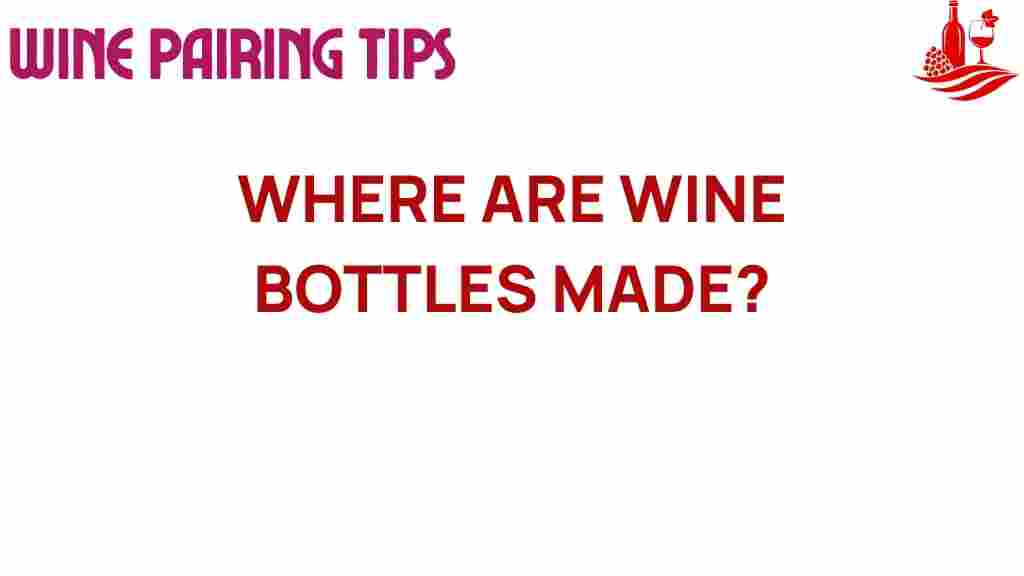Uncorking the Mystery: Where Are Wine Bottles Made?
Wine bottles are not just mere containers; they are an integral part of the wine industry, influencing everything from preservation to presentation. Understanding where and how wine bottles are made can enhance your appreciation for the craftsmanship behind your favorite vintages. In this article, we’ll explore the production process of wine bottles, delve into glass manufacturing, discuss sustainability in the wine industry, and highlight the importance of quality control in the global supply chain.
The Journey of Wine Bottles: From Idea to Shelf
The journey of wine bottles begins with the raw materials, primarily silica sand, soda ash, and limestone. These materials undergo a careful manufacturing process to produce the high-quality glass needed for wine bottles.
1. Raw Materials for Glass Manufacturing
- Silica Sand: The primary ingredient for glass, accounting for about 70% of the mixture.
- Soda Ash: Used to lower the melting point of silica, making it easier to form glass.
- Limestone: Adds stability and durability to the finished glass.
- Coloring Agents: Optional additives that can give the glass specific hues.
2. The Glass Melting Process
The first step in the production process is melting the raw materials in a furnace. The furnace operates at extremely high temperatures, typically around 1700°C (3090°F). This process can take anywhere from a few hours to several days, depending on the volume of glass being produced.
3. Forming the Glass Bottles
Once the glass is molten, it is shaped into wine bottles using one of two primary methods:
- Blow-and-Blow Method: This method involves blowing air into a gob of molten glass to form a parison, which is then transferred to a mold for final shaping.
- Press-and-Blow Method: A mechanical press shapes the glass, followed by blowing to expand it within the mold.
4. Annealing and Quality Control
After forming, the bottles undergo a process called annealing. This involves slowly cooling the glass in a controlled environment to relieve internal stresses. Following annealing, each bottle is subjected to rigorous quality control measures to ensure they meet industry standards.
5. Packaging and Distribution
Once the bottles are approved, they are packaged for distribution. This stage is crucial in the global supply chain of the wine industry, as the bottles must be transported safely to wineries and retailers.
The Importance of Craftsmanship in Wine Bottles
The craftsmanship involved in creating wine bottles is a blend of art and science. Skilled artisans and advanced technology work together to produce bottles that not only look beautiful but also serve a functional purpose. The design of the bottle can affect the wine’s aging process, as well as its overall presentation.
1. Design Considerations
Wine bottles come in various shapes and sizes, each serving different types of wine:
- Bordeaux Bottles: Tall and straight, ideal for red wines.
- Burgundy Bottles: Shorter with a wider base, often used for Pinot Noir and Chardonnay.
- Champagne Bottles: Thick-walled to withstand high pressure.
2. Customization and Branding
Many wineries opt for customized bottles to enhance their brand identity. This can include unique shapes, embossed logos, and specific color hues that reflect the winery’s image.
Sustainability in the Wine Bottle Production Process
As the world becomes more environmentally conscious, the sustainability of the wine industry has come under scrutiny. The production of glass bottles is resource-intensive, but there are steps being taken to improve sustainability.
1. Recycled Glass
Many manufacturers are now using recycled glass, which significantly reduces the energy required for melting raw materials. This not only decreases the carbon footprint but also conserves natural resources.
2. Lightweight Bottles
Another trend is the production of lightweight bottles. By reducing the amount of glass used, wineries can lower transportation costs and emissions. Lightweight bottles are also easier to handle, making them a popular choice for consumers.
3. Eco-Friendly Packaging
Beyond the bottles themselves, wineries are exploring eco-friendly packaging options. This includes using biodegradable materials for labels and recycled paper for boxes.
Challenges in Wine Bottle Production
Despite advancements in technology, challenges remain in the production of wine bottles. Here are some common issues:
1. Quality Control Issues
Maintaining high standards in quality control can be challenging, especially during high-volume production periods. Flaws in the glass, such as bubbles or uneven thickness, can lead to product recalls.
2. Supply Chain Disruptions
The global supply chain can be affected by various factors, including natural disasters, political instability, and economic fluctuations. This can lead to delays in the availability of glass and other materials.
3. Environmental Regulations
As regulations around sustainability grow stricter, manufacturers must adapt their processes to comply. This can lead to increased costs and the need for investment in new technologies.
Conclusion: The Future of Wine Bottles
The world of wine bottles is a fascinating blend of tradition, innovation, and sustainability. As the wine industry continues to evolve, so too will the methods and materials used in bottle production. By understanding the production process behind wine bottles, consumers can better appreciate the quality and craftsmanship that goes into each bottle. The future lies in balancing beauty, functionality, and sustainability, ensuring that wine bottles remain a vital part of the wine experience for generations to come.
For more information on the impact of packaging in the wine industry, check out this resource that discusses innovative packaging solutions.
To discover more about the fascinating world of wine, visit our blog for more articles on wine production, sustainability, and tasting tips.
This article is in the category Tips and created by Wine Pairing Tips Team
